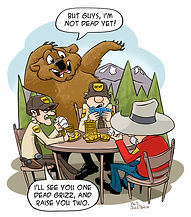Take action on behalf of grizzly bears and their habitat
Flawed Arguments
A Recipe For Killing
The Trust Us Argument of State Grizzly Bear Managers
Here, Dr. Mattson evaluates the argument made by the states that they should be trusted by the federal government and the public with primary authority to manage grizzly bears. The piece further examines the proposed Memorandum of Agreement (MOA) between the states that will guide post-delisting management. Dr. Mattson presents the results of a model simulating the effects of implementing the MOA, including the extirpation of male grizzly bears outside National Parks within roughly eight years of delisting. Dr. Mattson also examines the track record of Montana’s and Idaho’s management of wolves after delisting in 2011, as well as state management of grizzly bears that led to the decision by FWS to list them in 1975. He argues that the same state philosophy and culture are in place today that led to listing of grizzly bears in the first place.
Divvying Up the Dead
The piece describes the psychological drivers of grizzly bear managers, including fear of death, hard boundaries, lack of empathy, and fear of alien others, drawing on scholars such as Sigmund Freud, Irvin Yalom, Shalom Schwartz, and John Jost. Dr. Mattson then explains how this pathology has shaped the states’ Memorandum of Agreement for managing grizzly bears with its focus on killing, despotism, and jealously guarding power and privilege. Dr. Mattson concludes with critique of state wildlife management more broadly as a reflection of a small moral universe.
Hunting to Scare Grizzlies?
Kill grizzly bears to make them afraid of humans? This idea has gotten a lot of air time in recent years as one of several justifications for removing endangered species act (ESA) protections for Yellowstone’s grizzlies. The idea of instilling fear in grizzlies through a hunt is emotionally charged because there have been several bear-caused human fatalities in the Yellowstone region during the last few years. The media, of course, has duly sensationalized each death. So the idea is to have sport hunters kill grizzlies to teach them to fear people. Here Dr. Mattson challenges the narrative that hunting grizzlies will make them wary and fearful. Instead he argues that less fearful grizzlies are probably safer to be around. Tongue in cheek, this piece takes the "logic" of killing to scare to is illogical conclusion: kill cubs but leave their moms alive, and trap and beat adolescent bears to make them fearful. He concludes that the real motivation for hunting is not to increase fear in bears, but something darker.
Read more
Grizzly Threats
Arbitrary Lines on Political Maps
In its relentless push to delist Yellowstone grizzly bears, the US Fish and Wildlife Service (FWS) failed to address recovery at the scale of the lands that bears use. Rather, FWS employed a scale that was politically convenient -- excluding lands vulnerable to development and coveted by corporate interests. The agency’s approach to grizzly bears stands in stark contrast to that taken by the government when managing every other wildlife species in the Northern Rockies. Louisa Willcox examines the history and rationale behind the drawing of the Recovery Zone (also know as the Primary Conservation Area), and how that has become increasingly indefensible as an appropriate scale for protecting grizzly bear habitat. Willcox examines the serious threats to habitat that lie outside this line -- an area larger than the size of Yellowswtone Park -- and concludes with an alternative approach to habitat protection.
Read more





